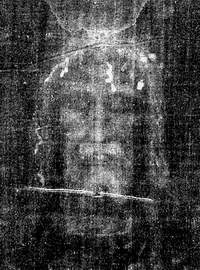 A new image because of the issue and come to the scientific theories on the Shroud of Turin. These days is the undisputed star of the alleged authenticity holds around and about the image of the face of Jesus, making him, in the possible Veronica mentioning the biblical texts.
A new image because of the issue and come to the scientific theories on the Shroud of Turin. These days is the undisputed star of the alleged authenticity holds around and about the image of the face of Jesus, making him, in the possible Veronica mentioning the biblical texts. The shrine that houses the relic, formerly known as "The mother of all icons", entrusted to the Capuchin, is in a small town (difficult to locate on the maps) of the Abruzzi, in the Apennines, about 200 kilometers from Rome.
The Holy Face is a veil of 17x24 inches. When the pilgrim approaches the veil, he discovers the image of a man who suffers from the blows of passion as Christ suffered.

SI Father Heinrich Pfeiffer, professor of iconography and history of Christian art in Rome's Pontifical Gregorian University, has studied for thirteen years the veil has been the first scientist to ensure that it is the veil of Veronica, who used to be guarded in the Vatican.
In the apocryphal Acts of Pilate (sixth century) speaks of a woman known by the name of Veronica, who wiped his face with a veil of Christ on the Cross.
Despite these uncertain sources, who are already in the century IV, according to Father Pfeiffer notes, German, history of the Veil of Veronica is present throughout the centuries in the Catholic tradition. In his film "Jesus of Nazareth", the film includes the director Franco Zeffirelli.
To celebrate the first Holy Year in history, in 1300, the Veil of Veronica became one of the "Mirabilia Urbis" (wonders of the city of Rome) for pilgrims could visit the Basilica St. Peter in the Vatican.
is confirmed by the greatest poet in the history of Italy, Dante Alighieri (1265-1321), singing XXXI of "Paradise " (lines 103-111) in the " Divine Comedy."
Traces of Veronica's veil were lost in subsequent years, the Holy Year 1600, when the veil was found in Manoppello.
Historical Studies cited by the father Pfeiffer, due to restructuring the Basilica of St. Peter by Pope Paul V (1605-1621), in 1608 struck the chapel in which guarded and it is likely that this time the relic was stolen.
In 1618, Vatican archivist Giacomo Grimaldi made a list of objects from the ancient Basilica of San Pedro, where he speaks of the shrine guarding the Veil, specifying that the windows were broken.
Pfeiffer's father explains that the veil of Manoppello in the bottom, you can still see a small fragment Previous glass reliquary, which demonstrates their origin from the Vatican.
According to the "Historic Relationship," written in 1646 by the Capuchin priest Donato da Bomba, in 1608 a woman, Marzia Leonelli, to get her husband out of jail, sold for 400 shields the Veil of Veronica , he had received as dowry, Donato Antonio de Fabritiis.
Since the relic was not in good condition, Fabritiis in 1638 gave parents Capuchin Manoppello.
This relationship, which no other historical evidence, diverging from the reconstruction of the Father Pfeiffer, telling the popular story of the arrival of the icon to the Abruzzi, in the hands of a pilgrim, in 1506. Until 1638, the icon would have passed through several hands. With the creation of this legend, say some researchers, could have tried to hide the theft of the Vatican.
Through sophisticated digital techniques, it has been shown that the image is identical on both sides of the veil, like a slide.

The Pascalis Blandina iconographer Shlöemer has shown that the image of the Shroud of Turin is perfectly superimposed to the Holy Face of Manoppello (with more than ten points reference).
Source: http://www.fluvium.org/textos/iglesia/igl494.htm

0 comments:
Post a Comment